#AZA zoos
Note
Hey uh I just found this out and I'm FURIOUS but miami zoo has a kiwi bird. Which is fine if they were doing what we do here and keeping it in a darkened enclosure with clear notices to be quiet and not bang on the glass. But instead this shy, solitary nocturnal bird is being kept in broad daylight and people are being allowed to pet it. NZ twitter is out for blood right now. https://twitter.com/zoomiami/status/1637864741954637824
…fucking yikes.
The kiwi I’ve seen in other AZA zoos have been kept according to the practices you describe: dark exhibit on a flipped light cycle, in a signed quiet area. What it looks like Zoo Miami is doing is… not good.
Here’s the link to their tweet with a video about the encounter (so it’ll embed):
The video shows a kiwi out of its exhibit: on a table in what looks like a back room with bright overhead fluorescent lighting. The kiwi has no room to move around and no place to hide as people pet it and reach around it to take selfies.

What do you pay to bother the kiwi four days a week - a species which in NZ is apparently illegal to touch without permission from the Department of Conservation? $25.
Obviously it just started and I don’t know anything more about it than what’s online, but even so, this is such a bad look for an AZA zoo, holy shit. I know a bunch of new ambassador animal rules just got promulgated… I wonder if this meets them. I’ll have to go do some reading. Also, USDA is now promulgating new bird rules (it didn’t regulate birds until just recently, only mammals) so this will also have to pass their muster soon.
The guy who runs Miami’s PR, and manages the animal media like the birth of their first kiwi chick in 2019, is known for big media stunts. I’m not surprised by this but I don’t think it’s going to go over well. There’s a lot of pressure on zoos to offer new encounters and programs to help make up for inflation and pandemic losses but this not how to do it.
I’d honestly suggest New Zealanders who are upset about this contact Zoo Miami formally (more than just on twitter) using the contact form on their website, and maybe even the AZA to express concerns about this program animal’s welfare - as well as the lack of cultural awareness at one of their accredited facilities.
Edited to add: a statement from Zoo Miami is supposed to be forthcoming tomorrow. I’ll update once we have it.
#AZA zoos#zoos#animal welfare#program animal welfare#zoo politics#kiwi#lack of cultural awareness is strong in this one
8K notes
·
View notes
Text
Im fucking sobbing looking at the new black footed cat at Utah's Hogle zoo
Shes just a fucking baby

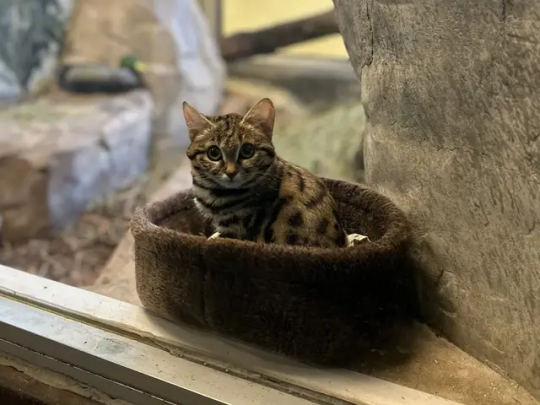
Baby with a 60% successful kill rate
#wrenfea.article#theres a video in the article#her name is gaia and shes 8 months#shes part of the AZA breeding program#i now have a reason to visit utah#leetle baby gorl#black footed cat#conservation news#conservation#zoos#animals#also the highest successful kill percentage for big cats is like. 25%#so 60% is fucking crazy
50K notes
·
View notes
Text
The wolf's fangs are like knives. They are made for killing, but their kills are utilitarian. To the wolf, killing is surviving. Killing is its nature. The wolf's fangs are utensils first and weapons second.
The bison has no pragmatic excuse for its horns. The bison doesn't kill to survive. Killing is not in its nature. The bison's horns are like swords, only there to hurt others in the name of self-defense, or to spar in the name of pride.
Humans fear the wolf's fangs because they understand the effectiveness of a pragmatic utensil. But humans are not the prey of wolves.
Humans should fear the bison's prideful defensiveness, for when your only protection is a sword, your only defense is a swift and ruthless offense.
#bison rambles#otherkin#therian#otherkind#therianthropy#anyways did you read about that one (aza accredited) zoo that encourages its keepers to have unprotected contact with hand-reared moose?#i think the keepers would be safer with the wolves
228 notes
·
View notes
Photo

(via GIPHY)
89 notes
·
View notes
Text
This is a really interesting article! I had no clue so few AZA facilities were true non-profits (only about 54%)!
Let this be a reminder that a zoo being “for-profit” does not mean they’re a front for greedy capitalists. Animal care, facilities maintenance, ex and in situ conversation, and a little something called paying your employees all take money, and a heckin’ lot of it. And more often than not, it’s safer and smarter to not rely on the kindness of donors to keep your zoo afloat.
#and even then zookeepers make pennies. PAY YOUR DANG ZOOKEEPERS!!!!#zoos#aquariums#aza#support zoos and aquariums
276 notes
·
View notes
Text
Any zookeepers on this hellsite have any advice for people looking to get into the field? I should be graduating next summer and I want to be a zookeeper in the NYC area
16 notes
·
View notes
Text
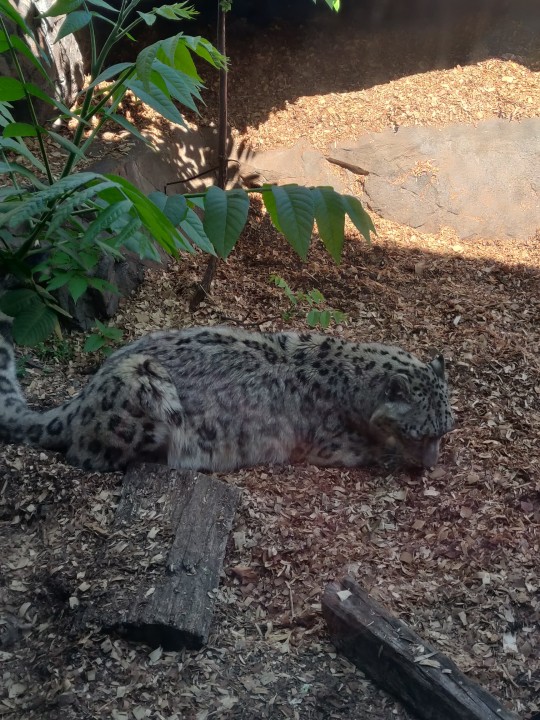
It's super hot here in the US so our already incredibly elusive snow leopard has been hanging out in his indoor, air conditioned, off exhibit enclosure more often lately. Today was a cooler day so this is the first time I've seen him in 2 weeks!
#aza zoo#snow leopard#snow leopards#felines#cats#big cats#wildlife#zoo animals#mammals#nature photography#naturalist#nature#asia#asian wildlife#wildlife biology#wildlife biologist#ecologist#ecology#mine
57 notes
·
View notes
Note
Is the Columbus zoo a good zoo to support? Its the only zoo I have access to but I wonder if it has any problems or anything
The Columbus Zoo is slightly tricky. They lost their AZA accreditation due to four zoo officials misuse of funds in 2021, which lost the zoo over half a million dollars. In addition to which, the AZA cited concerns about the zoo having a "long record of intentional and repeated animal transfers with non-AZA members intended to supply baby animals – mainly big cats – for entertainment purposes."
I don't have to tell you that that is terrible news, but things are looking up. Summer of 2022 Columbus Zoo gained ZAA accreditation, which holds weight. They are working on regaining their AZA status, so it appears these issues are on the mend. Ultimately the decision is yours, but I still think they are worth supporting. Go see the animals, ask questions, and get involved! I think it's fair to say that they wouldn't be ZAA accredited if they were still engaging in the shady practices that lpst them their AZA status.
118 notes
·
View notes
Text

"Summer's lease hath all too short a date."--William Shakespeare
Photo: Brookfield Zoo, Illinois
#flowers#nature#garden#brookfield zoo#chicagoland#chicago suburbs#aza#botanical garden#zoo#illinois#midwest#adventure#explore#land of lincoln#the prairie state#summer#end of summer#williams shakespeare quote#shakespeare#literary quotes#poetry quotes#poetry#september
17 notes
·
View notes
Text
I know this is literally such a me problem but every time I talk about zoos and people are like "I hate zoos, they're animal prisons, this 'sanctuary' let me ride an elephant though and I think that's cool :)" I want to chew through carbon steel
#screeching into the void#go to aza accredited facilities#this happens to me all the time at work since i volunteer at a zoo and i always have to hold myself back from being Queen Buzzkill the 8th
19 notes
·
View notes
Text
Things that apparently get me all emotional:
I’ve been a member of the Los Angeles Zoo for a little over a year now, and just renewed my membership a few months ago. This means that I get emails about the zoo’s conservation efforts, etc, and it always makes me emotional to see what good they’re doing and how hard they try.
Today, I got an email about their 20-year plan, and y’all? I’m in tears. I’m so happy. They’re focusing not just on animal welfare and conservation, but on accessibility. For the first time ever, the pedestrian walkway is going to be entirely ADA-compliant, and rather than build a parking structure which encourages more people to visit by car, they’re building a massive solar panel section and working on improved public transport to the park.
They’re improving habitats across the zoo, and for the first time in zoo history, they’re going to put the California condor on display, which is a massive deal, because LA Zoo helped (and continues with conservation efforts to this day) to bring them back from the brink of extinction.
They have a massive area of native oaks that they’ve decided to leave alone and use as research for local environmental changes and preservation of local flora and fauna.
They’re rebuild/improvements will better utilize their space to not only expand and improve the habitats of all their animals, but to help the public connect with these animals in natural areas. For example, there are plans for an improved hippo pool with an underwater viewing area.
I don’t talk very often about how concerned I am for the natural world, but it’s one of those things that quietly eats me up. I’m proud to be a member of the LA Zoo, which in turn is a member of the Association of Zoos and Aquariums. Their global conservation efforts are groundbreaking and award-winning.
I’m just really emotional right now, guys. Go visit your local zoo or take a walk somewhere natural, and be awed by the wild parts of our planet.
16 notes
·
View notes
Text
Happy National Zookeeper Week!
I’ll admit, I’m feeling a little spicy about it this year (well, every year) because zoos use the celebration for lots of positive facility PR, yet staff don’t often get the support and respect that is claimed in those posts.
So I want to share this great article written by a zoo industry consulting group last year looking at the reality of what happens when a workforce ends up conflicted between their passion (zoos and animals) and pragmatism (paying rent, existing in a capitalist society). They assessed AZA compensation rates by region against things such as a living wage and rental rates in the area. (All text formatting within quotes, such as bold and italics, is original to the article text.)
I cannot give the Canopy Group enough support for the way they framed this research:
“By observing the economics of keeper compensation, it’s no secret that keepers land on the lower end of the wage spectrum. Like all other wages and salaries, the market value of keeper compensation is driven by several economic factors – including the size of the labor pool, the rigor and danger of the work, the technical ability required, and the educational requirements. However, there is one factor that artificially lowers the market value of keeper compensation more than any other: passion.
In this article, we’ll take a look at why passion lowers the market value of animal care worker wages. More importantly, we’ll consider many factors that have emerged in recent years that are making people reevaluate the value of following their passion – a trend contributing to The Great Resignation, especially as it applies to zoos, aquariums, and similar organizations. (…)
The argument here is passion versus pragmatism: the unknown versus the sure thing. It is a decision all zookeepers and animal care technicians have made. Working with animals is immensely rewarding, but this passion is also very popular. This, historically, has meant that the keeper candidate pool is very large. Therefore, if the wage is livable and working conditions are reasonable, the pool should remain large. In a very real sense, a passion for animals drives down the market value of keeper compensation. Anyone who has been through an Economics 101 course will recognize this as a fundamental market principle: supply vs. demand.
However, many zoos and aquariums are having a more difficult time filling positions than normal and have started to see higher turnover rates in recent years. This begs the question – is the current keeper wage too low?”
Their findings?
Here’s their graph of “the median wage of keepers from organizations in different AZA-defined regions” from an AZA survey done in 2021. (Median is the type of average that looks at the middle of a data set’s range).
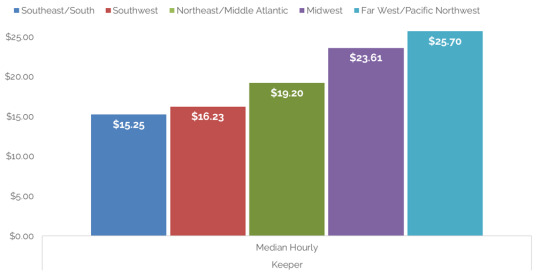
The median wage for AZA keepers in the South/Southeast was just over $15/hr at the low end, and the median wage for AZA keepers in the Far West / PNW was a little under $26/hr. That’s pretty dang low everywhere, especially when you factor in the increased cost of living in places like the West Coast. Also consider that looking at the median wage doesn’t mean this reflects just entry-level compensation - this data indicates the the compensation middle for all keeper positions, including people who have built their careers as keepers in those places long-term.
Then, they compared those wages to the “living wage” in each region - which they defined as “a calculation of what it takes to live in a particular area, without any other income. A living wage calculation takes into consideration how many earners are in a household, how many children are being supported, etc. The living wage includes the costs of all the basic items a household needs to be self-sufficient.”
“If you receive a wage for a job that is below the living wage, then you are essentially taking a negative net income. This is unsustainable for the long term, and essentially defines where wages start to exploit passion.”
Here’s a figure they provided using the MIT Living Wage Calculator showing the average living wage for each of the AZA regions. The chart on the left shows the living wage for a single person with no kids; the second, for two parents with two incomes and one child to support.
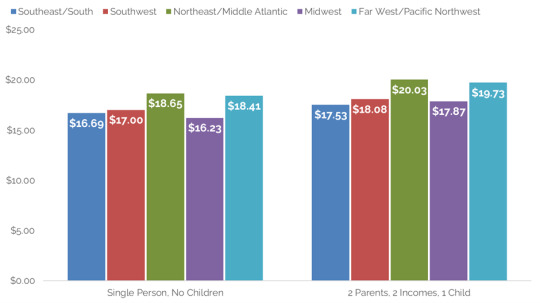
“By comparing the two graphs [to the earlier graph of the AZA median compensation rates], we find that median wages in the Southeast/South and Southwest regions are lower than the living wage for each household configuration in those regions. In other words, if you are a single person household or part of a two-income household raising 1 child in the South, a starting keeper salary will likely leave you with a negative net income. While many people work at this level, it increases the risk of accumulating debt, lowers a person’s ability to afford a home, set a much later retirement age, and can lead to many other negative, long-term effects.”
Big yikes, right?
Next, they looked at living wage vs. compensation for single parents.

“The single-parent living wage exceeds the average keeper wage in all AZA regions. In fact, the living wage required as a single parent is double the average AZA keeper wage in some regions.”
And then they did housing, specifically, being able to purchase a home.
“In many places, even a two-income household at an average keeper salary would not purchase a mid-level home. This means that keepers have to wait far longer than their peers to purchase a home. While paying rent in the meantime, this rent will account for a larger portion of their income than their peers. All in, these effects can set hopeful homeowners back years or decades.”
Canopy’s conclusion was something anyone involved in the field knew was coming.
“Companies like Chipotle, McDonalds, Best Buy, FedEx, Home Depot, Publix, and Walmart are all offering similar starting wages near starting keeper wages – plus many fringe benefits (like tuition reimbursement) and ample advancement opportunities. Many potential keepers in younger generations are putting their passion on the shelf so they can meet basic standard-of-living concerns.
To attract and retain quality candidates, an organization must consider the journey each new employee would have to make over their career. If the journey is fraught with massive debt, decreased disposable income, and limited career opportunities, then you are limiting your potential candidate pool to the small group of people who have decided that following their passion is worth significant lifelong financial hardship. There are many potential candidates out there willing to sacrifice and arm and leg for animals and conservation, but they wouldn’t dare jeopardize the financial future of their dependents and families.”
This is something I’ve heard about for years, and seen first hand. The low average wage at zoological facilities has been damaging their ability to hire and retain skilled staff for as long as I’ve been involved in the industry. I know so many zookeepers who still have roommates into their 30’s, or work multiple jobs, just to be able to make ends meet.
There’s a mythology about zookeeping jobs, a narrative that seeps into the field and actively exploits people’s passion for the job: it tells people that they’re so lucky to be able to work with these rare and cool animals; that they’re greedy and ungrateful when they ask for more compensation because they’re privileged to get to have the job at all. It says that most people would give anything to have these opportunities, so current zookeepers are interchangable and easily replaceable. Ask for too much? Push for a living wage? There’s always someone willing to take your spot. Not all facilities perpetuate this mentality - some places do treat their staff well without intentionally manipulating them to stay them in unsustainable jobs, and there can be legitimate financial reasons that limit staff compensation (mostly at smaller facilities, afaik) - but it’s a reality in the field.
For a long time, this type of mentality towards staff was sustainable. There really were always more people wanting to work in the field. But now, after three years of pandemic stressors and inflation, it’s starting to be a problem. A lot of staff left during the last few years, and facilities are having a really hard time hiring people and retaining them for any duration. I think a large part of that is low compensation rates. People are prioritizing long-term financial stability and recognizing when their passion is being exploited.
When I first started on tumblr back in 2011, there was a whole group of us within the United States who were baby zookeepers or volunteering as industry hopefuls. We all became friends, and I’ve stayed in touch with, or at least aware of, most of them as their careers progressed. Of the 10-15 or so people in that cohort? I can think of three who are still employed in the zoo industry. Everyone else has moved on into other fields - often with great grief over the loss - because of the extreme emotional labor, the physical exhaustion, and the lack of appropriate compensation.
But I guess that annual pizza party, being featured on social media, and maybe getting additional snacks all week makes up for it all?
#national zookeeper week#zoo industry#living wage#compensation#please support your local zookeeper#AZA accreditation#AZA zoos#zoos
552 notes
·
View notes
Text
School starts in one week
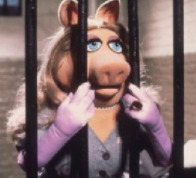
#txt#I am ready to improve myself and actually get something that will better my future lmao#I am taking one Major rn and will apply for some secondary courses in hopes for internships at AZA zoos so fingers crossed#Like imma take the best care of these living beings
10 notes
·
View notes
Text
people who are against zoos existing make my head hurt. its like such a popular opinion and 99% of it is based in straight up misinformation or pure emotional opinions instead of any amount of facts
#i would argue that most people who dont agree with the existence of zoos arent aware that the aza even exists#because why use google when being wrong out loud is easier#there ARE unethical zoos but if youre sitting here talking about how an aza accredited zoo that is instrumental in conservation work should#be shut down youre actually crazy#'we shouldnt have zoos we should just have sanctuaries' quick define both of those words for me right now#would surprise most people to find that a lot of aza zoos fall into their definition of sanctuary#and a lot of self proclaimed sanctuaries fall into their definition of a zoo#its literally not a black and white issue. its insane to think that in 2024 every animal can live in its natural habitat safely#WE ruined that for them. how is it fair for us to ruin their habitat and then be hateful towards the only institutions helping them?#simon says
3 notes
·
View notes
Photo

(via GIPHY)
78 notes
·
View notes
Text
Well everyone, I performed my first ever cetacean ultrasound today!
My “patient” is in excellent health, and this session was meant merely as practice both for me and for her—ensuring she remains comfortable holding still for scans. Because whales and dolphins are too big for manual palpation or x-rays, ultrasound is how veterinarians visualize their internal organs and ensure they remain healthy. Cetaceans in human care routinely receive ultrasound scans to monitor their health, even if they are not ill or pregnant.
And it’s a great example of cooperative care! Unlike dogs and cats, which have to be sedated or manually restrained by humans in order to get diagnostic ultrasound images, cetaceans in human care are trained to float in place while the veterinarian places the ultrasound probe on them. They are free to leave the session at any time. And there’s no need for ultrasound gel, because the water acts in its place!
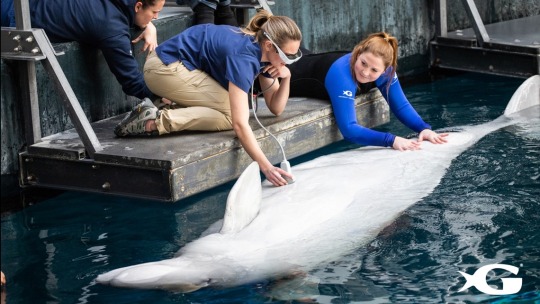
(Photo not of me… published by Georgia Aquarium when their beluga Whisper was pregnant with her calf Shila)
All in all, a great end to my externship!
#very sad to leave… but I’m heading directly to my next externship tomorrow!#another aza facility with cetaceans#my third and final externship will actually be right after I graduate because I couldn’t fit it into my clinical year#whales#dolphins#belugas#orcas#cetaceans#marine mammals#animal training#animal husbandry#vet med#zoo med#aquatic med#vet school#vet student#externships
92 notes
·
View notes